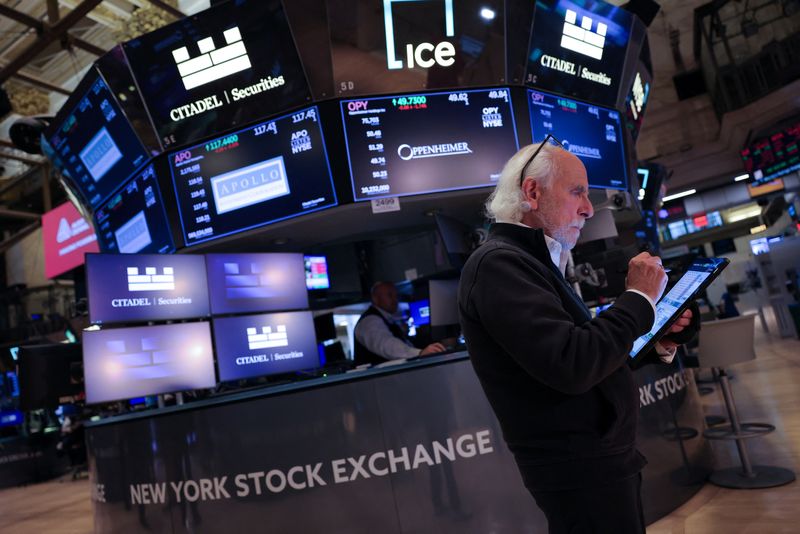Wall St propelled higher by broad gains after Fed kicks off easing cycle
By Johann M Cherian and Purvi Agarwal
(Reuters) - Wall Street's main indexes soared on Thursday with the S&P 500 and the Dow hitting intraday record highs after the Federal Reserve kicked off its monetary easing cycle with half-a-percentage point reduction and forecast more interest rate cuts were on the horizon.
Rate-sensitive growth stocks that have led much of this year's gains climbed, with top players such as Microsoft (NASDAQ:MSFT ) adding 1.9%, Tesla (NASDAQ:TSLA ) gaining 7.1% and Apple (NASDAQ:AAPL ) advancing 3.4%.
Semiconductor stocks such as Nvidia (NASDAQ:NVDA ) jumped 5.3%, while Advanced Micro Devices (NASDAQ:AMD ) gained 6% and Broadcom (NASDAQ:AVGO ) added 4.7%, sending the Philadelphia SE Semiconductor Index up 4.8%.
The Russell 2000 index , which tracks small caps, also trended 1.8% higher with the broader market, as a lower interest environment boosted prospects of lower operating costs and greater profits.
At 11:49 a.m. the Dow Jones Industrial Average rose 428.60 points, or 1.03%, to 41,931.70, the S&P 500 gained 97.47 points, or 1.73%, to 5,715.73 and the Nasdaq Composite gained 488.76 points, or 2.78%, to 18,062.06.
Eight out of the 11 S&P 500 sectors gained, led by tech stocks with a 3.4% rise, while defensive sectors like utilities and consumer staples trended lower.
After delivering its super-sized verdict on Wednesday, the Fed forecast rates to fall by another 50 bps in 2024, and unveiled macroeconomic projections that analysts say reflect steady growth and lower unemployment.
"Markets are acting well to yesterday's messaging from the Fed. They wanted to hear we weren't falling into recession which Chair Powell reassured that the economy is on good footing," said Bret Kenwell, investment analyst at eToro.
"A soft landing is still in play; that's still the default expectation. However, there's still clearly some concern that the labor market is going from a period of softness to weakness."
Data showed jobless claims for the week ended Sept. 14 dropped to a four-month low, pointing to solid job growth in September.
Traders now see a 61.1% chance that the central bank will lower interest rates by 25 basis points at its November meeting, as per the CME Group's (NASDAQ:CME ) FedWatch tool.
BofA Global Research now anticipates a total of 75 bps rate cuts by the end of this year, compared with 50 bps forecast earlier.
Evercore ISI data going back to 1970 showed the S&P 500 has posted an average 14% gain in the six months following the first reduction of a rate-cutting cycle.
September has generally been a disappointing month for U.S. equities with the S&P 500 notching an average loss of 1.2% since 1928, but has gained over 1% so far this month.
The broader banks index trended 2% higher, pulled up by big banks such as Citigroup and Bank of America after they lowered their respective prime rates.
Among individual movers, fertility benefits management firm Progyny (NASDAQ:PGNY ) plunged 30% after a significant client notified the company it had elected to exercise a 90-day option to terminate its services agreement.
Advancing issues outnumbered decliners by a 4.04-to-1 ratio on the NYSE and by a 3.88-to-1 ratio on the Nasdaq.
The S&P 500 posted 51 new 52-week highs and no new lows, while the Nasdaq Composite recorded 134 new highs and 47 new lows.
Source: Investing.com
